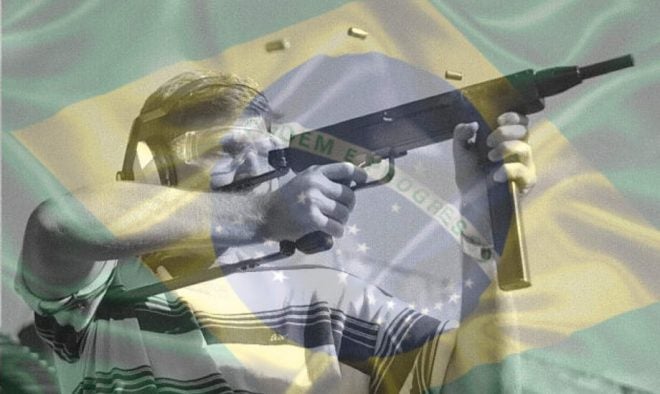Shortly after completing the previously-described (https://www.thefirearmblog.com/blog/2018/02/28/brazils-ina-submachine-gun-reloaded-part-2/) .45 ACP-to-9x19mm INA conversion at Brazilian Army’s Arsenal de Guerra General Câmara, in the Rio Grande do Sul State, the very same officer in charge was transferred to IMBEL’s Fábrica de Itajubá, Minas Gerais State, as head of the facility’s Research Department in 1982. It then appeared that the Army was still interested in giving the M.B.50 and M.953 submachine gun stocks a new breath of life, thus authorizing the Itajubá Factory guys to go ahead with new projects. The basic idea was for the factory to supply full conversion kits (barrels, bolts, magazines, etc.) to interested parties, mainly police agencies, so that they could carry out the transformation work themselves.
From that time on, several INA variations emerged from FI’s research office and experimental workshop facilities, some of them reaching limited scale production and local LE service use. No official designations were generally given, other than varied markings on the guns indicating they were IMBEL-made “Transformers”. What follows is the author’s own “Version X” name system based on successive weapons encountered during visits to Fábrica de Itajubá in the 1980s and 1990s.
While I’ve never obtained official production figures from the manufacturer, a search in my own not-too-organized files indicate that about 5,000 INAs had been transformed to 9x19mm by IMBEL by February, 2001, with deliveries to the Brazilian Army (1,000 examples) and police forces of such states as Alagoas, Minas Gerais, Pernambuco, Rio de Janeiro, Rio Grande do Norte, São Paulo, and Tocantins.
Version I:
This modification appeared in 1982 and involved the idea of being made available in the form of IMBEL-supplied kits containing a new 9x19mm barrel and the corresponding bolt assembly, plus a new 30-rd magazine with rounds inspection windows on the right side. Another modification came in the form of the magazine housing, to which a small lever was added below the original release switch so that its actuating action was inverted from pull-back to push-forward. The INA remained otherwise unchanged, thus keeping the safe-full-auto-only selector button on the left side, just above the trigger. Apart from a few tool room prototypes, no full production was undertaken.
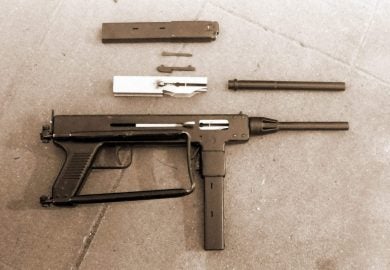
The first Fábrica de Itajubá-made INA conversion to 9x19mm is shown here with the components kit that would be supplied for users to carry out the transformation themselves.
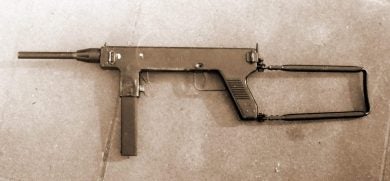
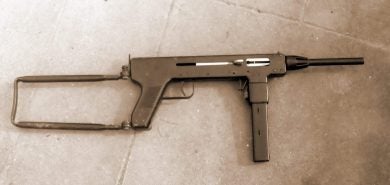
Left and right side views of Version I (author’s designation), tubular stock extended.
Version II:
This was the first model to be made in series and, like most of the follow-up versions used the M.953 (the one with the longer magazine housing) as a starting point. The visual distinguishing feature was a long, 5-slot compensator added to the 220mm barrel to aid controllability in automatic fire, the weapon keeping the original unavailability of a semi-auto option. The .45 ACP magazine was used, although having the side walls molded inwards to accommodate the 9x19mm rounds. Following its official product certification (ReTEx No. 1070, July 30, 1984) by Brazilian Army’s Campo de Provas da Marambaia (Marambaia Proving Grounds), it was subsequently ordered and put into use by Rio de Janeiro’s Civil and Military Police agencies, among others.
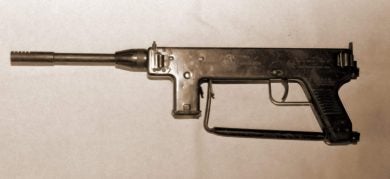
Version II (author’s designation) was the first conversion to be series manufactured by IMBEL, having been product-certificated by the Brazilian Army in 1984.
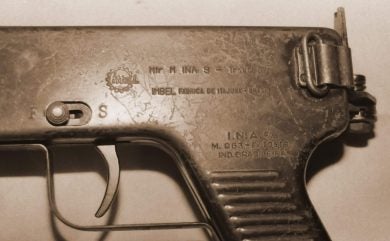
A closer view of the same gun, oddly marked as “M.963” (instead of M.953) Serial Number Fx. 10518, to which the IMBEL logo and the markings “Mtr M INA 9 – Transf p/ – IMBEL FÁBRICA DE ITAJUBÁ BRASIL” were added. Note Fire/ Safe sliding selector switch above the trigger.

An M.B.50 (top) in 45. ACP compared to an M.953 Version 2 in 9x19mm, the sole external ID feature being the compensator added to the 220mm barrel.
Version III:
This variation incorporated additional changes, very significant being the addition of a semi-auto setting in the lengthened fire selector switch area, marked “S” (Safe, forward), “R” (Repetition, center), and “A” (Automatic, rear), cyclic rate of fire being 600-620 rounds per minute. Visible external changes were a slightly extended tubular stock (not interfering with the grip safety, when folded), and a metal structure covering the suspicious-looking, outward projection of the guide rod, when the gun fired.
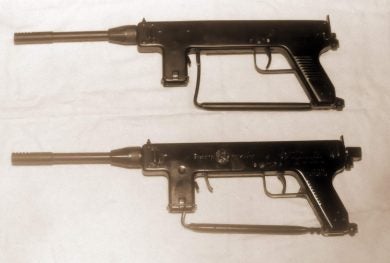
When folded to the right side, the Version III (bottom gun, in photo) lengthened stock’s buttplate did not cover the forward grip safety lever. Note the small guide rod protection structure at the rear of the receiver. Top INA in the picture is the earlier Version II, with the original stock.
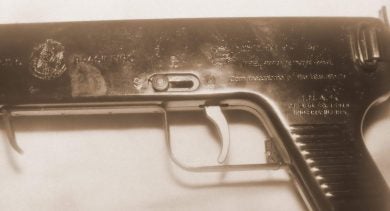
The three-position (S-R-A) fire selector fitted to Version III. Barely readable is the inscription “Com mecanismo p/ tiro intermitente” (With mechanism for intermittent fire) added to other markings.
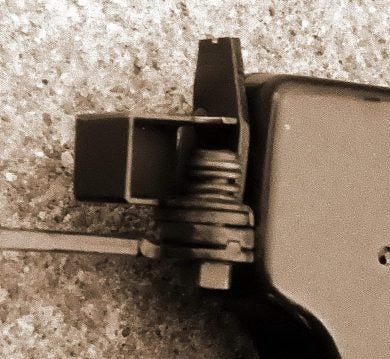
This close-up view clearly shows the box-like structure added as a protection against possible accidents caused by the recoil spring guide rod, which protrudes from the rear end of the receiver during firing. Also, note the gun’s U-shaped rear sight.
Version IV:
The next INA 9x19mm transformation to emerge from IMBEL’s Fábrica de Itajubá was also a selective-fire subgun, although the fire selector was quite different from the previous model. It consisted of a lever located on the left side above the trigger which turned on a wide 180 degrees with the settings “R” (front), “S” (top), and “A” (rear). A more usual “S”-to “R”-to “A” sequence was not used, according to the manufacturer, because this would involve a more complex (and costly) re-work, which was not desirable. Other details were the same as in the precedent Version III. Official Brazilian Army product certification (ReTEx No. 1184) was issued by Campo de Provas da Marambaia on May 21, 1986, which allowed the gun to be sold to LE agencies, which it did.

Right side view of a Version IV gun, stock folded. Note pressed-in walls of the original 30-round magazine to accommodate de 9x19mm rounds. The inset shows the 5-slot compensator added to the 220mm barrel (4 grooves, RH, 1:254mm twist).
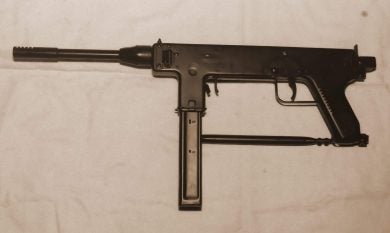
As seen from the left side, it will be noticed that the magazine has rounds inspection windows at the 30- and 20-rd positions.
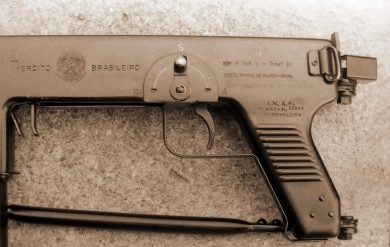
This closer view of an “EXÉRCITO BRASILEIRO” (Brazilian Army) M.953 Version IV INA better shows the fire selector configuration. Markings to the right read: “Mtr M INA 9 – Transf p/ – IMBEL FÁBRICA DE ITAJUBÁ BRASIL – Com mecanismo para tiro intermitente”.
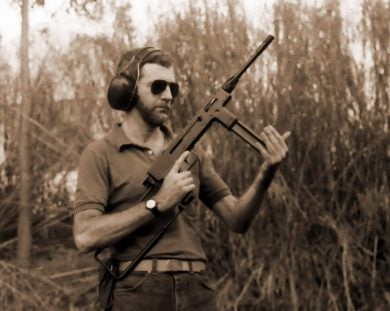
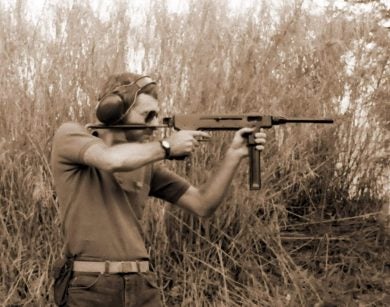
Author and a Version IV at the Itajubá Factory range back in the mid-to-late 1980s. Cyclic rate of fire was around 620 rpm at full auto.
Version V
IMBEL’s last venture in upgrading the old INAs came in 1992, or so, when one of the weapon’s LE users (reportedly, Bahia State Military Police) asked for some additional changes to be made to the basic design for the creation of an informally-called “Modelo Policial” (Police Model). Changes included the reduction of the barrel length from 220 to 153mm (no compensator fitted), the redesign of the trigger shape to place it closer to the pistol grip, making the staggered-row 30-round magazine a two-position feed type, and (as in the original Madsen M1946!) moving the re-shaped cocking piece to the top of the gun. In this new configuration, an overall reduction in size and weight was achieved.
Some other changes to the INA were also made, but these concentrated on the manufacturing of firing mechanism components, from originally machined from laminated steel blanks to either MIM (Metal Injection Molding) or Investment Casting processes, but author’s memory is somewhat vague as to which…
Version V apparently did not reach large-scale production, but IMBEL had finally, but tentatively, given it official designations: Mtr M INA MD1 (modified M.B.50) and Mtr M INA MD2 (modified M.953). IMHO, it was the best of them all!
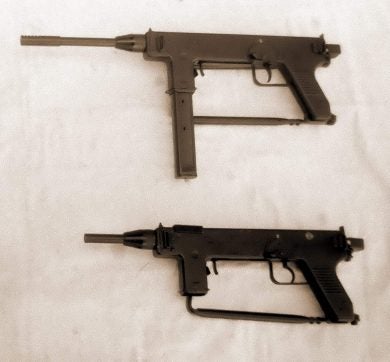
A comparative view of Versions IV and V, the degree of compactness achieved by the latter being evident. Also note the reshaped trigger, brought closer to the pistol grip.
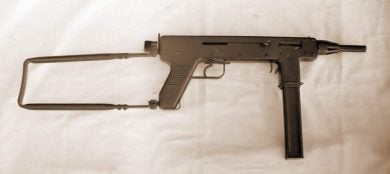
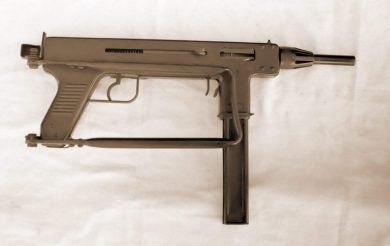
Views of Version V with the tubular stock extended (overall length, 754mm) and folded to the right side (494mm).
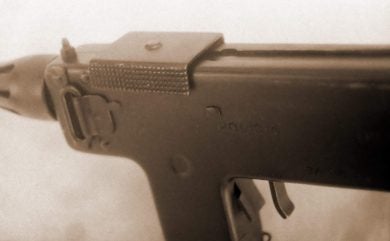
The re-shaped and re-positioned cocking piece (or charging handle, if you will) was a return back to the original Madsen M1946 design.
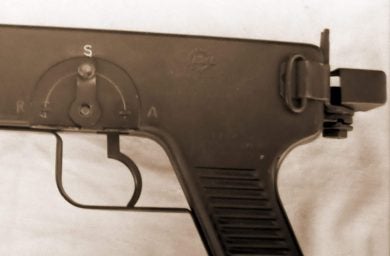
Fire selector and trigger of Version V. The boxlike protection from the protruding recoil spring rod (when firing) was maintained.
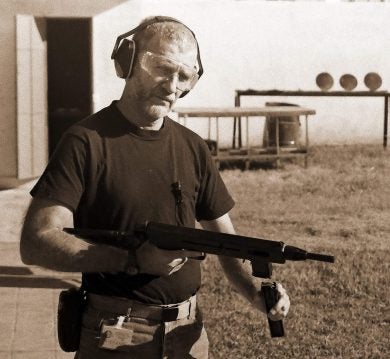
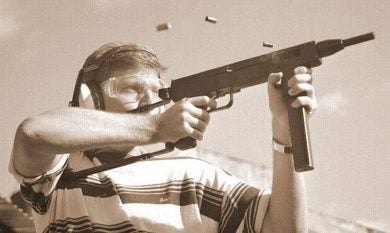
Author preparing to insert the 30-round, two-position feed magazine in the gun… but left the “fun photo” for son Alexander!
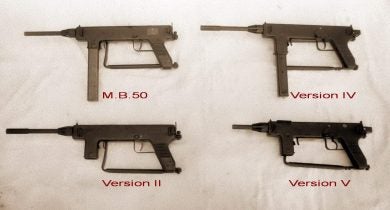
An original INA M.B.50 and some of the IMBEL 9x19mm transformations.
Higher-res pics? Yup: https://imgur.com/a/ipld0
 Your Privacy Choices
Your Privacy Choices
